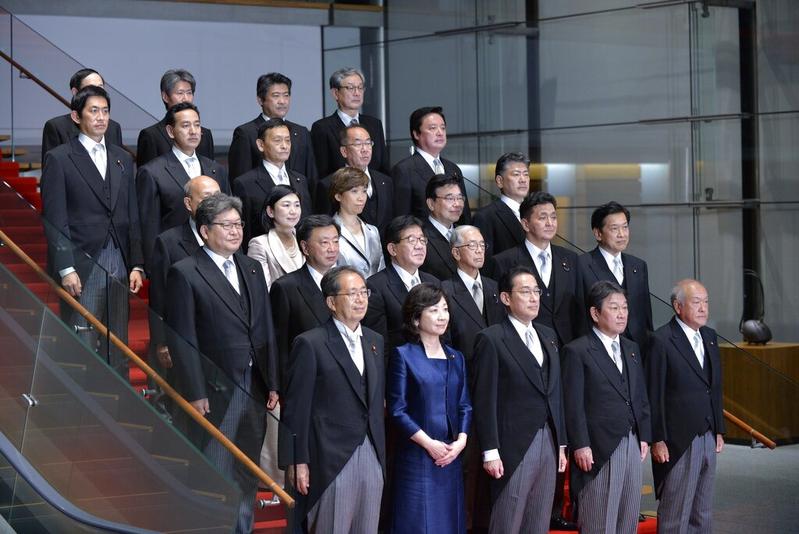Analysts expect no major economic policy changes from Abe era despite new faces
 Newly elected Japanese Prime Minister Fumio Kishida poses with his cabinet members at the prime minister's official residence in Tokyo, Oct 4, 2021. (DAVID MAREUIL / POOL PHOTO VIA AP)
Newly elected Japanese Prime Minister Fumio Kishida poses with his cabinet members at the prime minister's official residence in Tokyo, Oct 4, 2021. (DAVID MAREUIL / POOL PHOTO VIA AP)
TOKYO-Fumio Kishida, leader of Japan's ruling Liberal Democratic Party, was elected on Monday as the new Japanese prime minister, the 100th in the Northeast Asian country's political history.
But in the face of continued deflationary trend, declining population rate and other structural problems, including digitizing and greening its economy in the COVID-19 era, the Kishida Cabinet is under pressure to lead Japan down a stable growth path.
The Japanese economy faces multiple challenges both domestically and abroad.
The country's wealth stratification has increased as deflationary pressures persist. The ultra loose monetary policy introduced during the administration of former prime minister Shinzo Abe has led to a sharp rebound in Japan's stock and property markets, with wealthy households benefiting from the rise in asset prices.
Ordinary people have failed to benefit from asset inflation, and their real incomes have fallen instead of rising, leading to less spending, which has made it difficult for Japan's economy to emerge from deflation.
Japan also faces the heavy burden of a low birthrate and an aging population. As the number of elderly Japanese continues to increase and the population rate remains in negative growth, Japan's economy is confronted with a labor shortage, a shrinking market, unsustainable social security and a serious fiscal deficit.
The new Cabinet needs to also address new challenges in digitizing and greening its economy. Japan's digital economy is lagging behind and faces multiple traditional and institutional obstacles. The slow development of an e-government has become a bottleneck in Japan's fight against the COVID-19 pandemic.
The government's goal of achieving carbon neutrality by 2050 is also a major test for the transformation of Japan's energy and industrial sectors. The digitization and green transformation of the economy requires profound reforms.
Through fiscal policies and tax adjustments to encourage enterprises to increase wage distribution, Kishida plans to bolster incomes and expand the country's middle class in order to stimulate consumption, combat a shrinking market and sluggish investment, and achieve a virtuous circle of sustained economic growth.
Kishida said he would come up with economic measures worth trillions of yen, and provide more financial assistance for housing and education to families with children.
He also pledged to raise the wages of nurses, nursing workers and childcare workers, and drive up wages elsewhere in the private sector. He also proposed improving digital infrastructure and correcting Tokyo's unipolar development to narrow the gap between regions.
The Kishida Cabinet also set up a new ministerial post for economic security and plans to formulate relevant national strategies.
Structural reform
Analysts generally agreed that Japan's cabinet, despite the new faces, is not fundamentally different from the Abe era and is unlikely to completely change its policies. In particular, Japan's ultra loose monetary policy will continue as deflation drags on.
In addition, a proactive fiscal policy will remain in place to stimulate the economy and promote structural reform.
Analysts also believed that the virtuous circle of expanding distribution remains just a vision at present, and realizing this goal involves national tax reform and a profound change in income distribution from enterprises, which cannot be accomplished overnight.
Toru Morotomi, an economics professor at Kyoto University, pointed out that with Japan's current industrial structure, the expansion of consumption can only stimulate the economy in the short term, and finding a way to stimulate medium- and long-term economic growth is key. Kishida has so far revealed no further details on the issue.
Xinhua - Agencies



